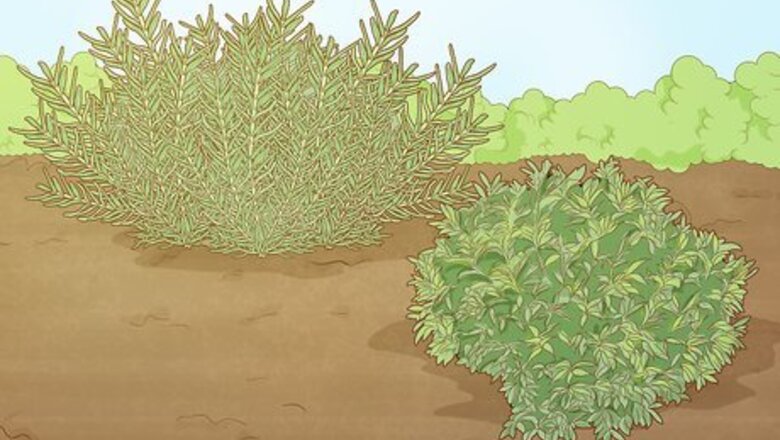
views
Choosing Your Shrubs
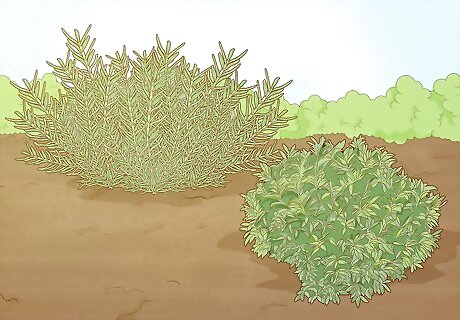
Pick an evergreen shrub if you want privacy year-round. Evergreen shrubs retain their foliage throughout the year so they will always grow and look full. Visit your local plant nursery and check what varieties of evergreen shrubs they have. Look for plants that grow well in your climate zone, or else your hedge may look less full or leggy. Some evergreen hedges you can choose include arborvitae, boxwood, juniper, and photinia.
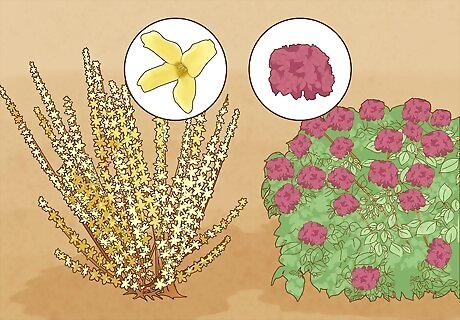
Select deciduous bushes to have flowering plants during the spring and summer. Deciduous bushes tend to have bright blooms throughout the growing season, but their leaves will die back during the cold season. Even when the plants lose their foliage, deciduous shrubs can still provide privacy and protection when they have thick branches. Check your local garden store to find what types of shrubs survive well in your area. Deciduous shrubs you can use include forsythia, weigela, lilacs, rosa rugosa, and quince. Some deciduous plants have thorns on their branches, which can help protect your yard or garden from large animals, such as deer.Warning: Avoid using plants like Japanese barberry, burning bush, autumn olive, or privet since they are considered invasive and can quickly grow out of control if you aren’t able to maintain them properly.
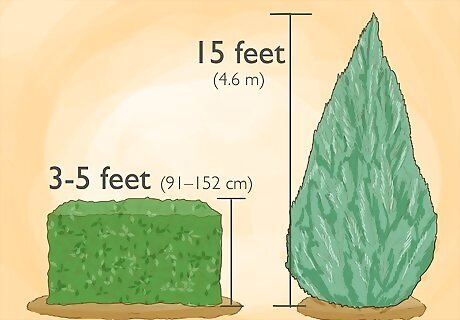
Look for shrubs that only grow to your desired height for easier care. Some shrubs can grow larger than 15 feet (4.6 m) tall, which will take more time to prune and control if you want them shorter. Look at the maximum sizes for the shrubs that you’re interested in and make sure they’re similar to the height where you want to maintain them. If you just want a small, natural wall, opt for shrubs that are 2–3 feet (0.61–0.91 m) tall. If you want something more private, opt for shrubs that grow to 4–6 feet (1.2–1.8 m). Boxwood, weigela, and forsythia all grow around 3–5 feet (91–152 cm) tall. Shrubs like photinia, arborvitae, and juniper usually grow to around 10 feet (3.0 m) to 15 feet (4.6 m) if they’re left unpruned, but they can easily be controlled. Aim to keep the shrubs at eye level so you don’t have to use a ladder to trim the higher branches.
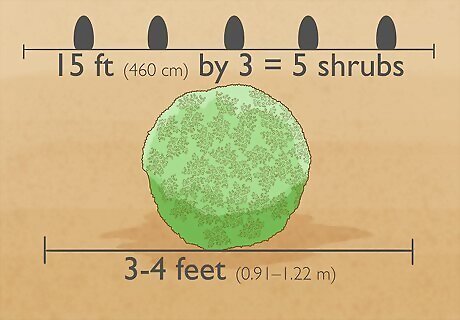
Buy 1 shrub for every 3–4 feet (0.91–1.22 m) you want for your hedge fence. Opt for shrubs already grown in pots or that have their roots wrapped in burlap since they’ll be easier to grow than seeds. Divide the length that you want for your hedge fence by 3 feet (0.91 m) and round up so you know how many shrubs you need. Buy the same species of shrub so your hedge fence looks uniform. For example, if you want a 15 ft (460 cm) hedge fence, you would divide 15 by 3 to get 5. Therefore, you will need to plant 5 shrubs. You can choose different species of shrubs if you want your fence to have a more natural look, though it may not grow as dense.
Planting the Shrubs
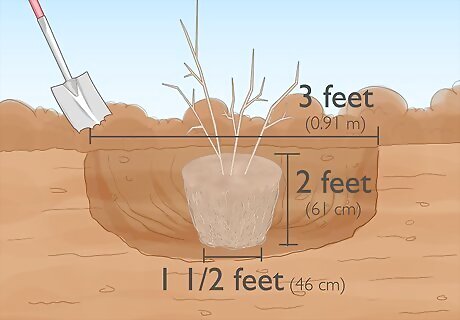
Dig a trench 2 times wider and the same depth as the largest shrub’s root ball. Measure the diameters and heights of the root balls for each shrub you purchased with a measuring tape to find the largest. Find the spot in your yard where you want to plant your hedge fence and begin digging with a shovel. Start with the middle of the trench first before expanding it wider so you can easily measure the size. For example, if the root ball was 1 ⁄2 feet (46 cm) wide and 2 feet (61 cm) tall, then your trench should be 3 feet (0.91 m) wide and 2 feet (0.61 m) deep. You can also rent a mini-excavator or trench digger from a heavy machinery supply store if you want to dig the trench more quickly.Tip: Spray paint the outline of the trench on the ground so you can see how much more you need to dig.
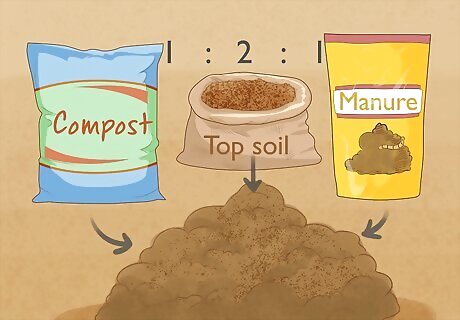
Mix compost and manure into the excavated soil to provide more nutrients. Look for bags of compost and manure at your local gardening center. Pour 1 part compost and 1 part manure for every 2 parts of soil that you dug out of the trench. Use your shovel to turn the compost and manure into the soil until it’s thoroughly mixed together. You can also use your own compost for your hedge. Mix the soil with your manure and compost in a wheelbarrow if it’s easier for you.
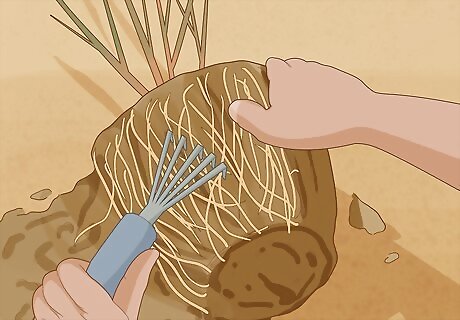
Tease the roots out from the shrubs with a hand cultivator. A hand cultivator is a small metal claw that breaks apart soil without ripping through the roots. Pull the shrubs out from their pots by the base of the trunk or cut through the burlap around the root ball. Drag the claw of the cultivator gently across the soil around the roots to expose them. Don’t remove all of the soil from the root ball, or else you could damage the shrub. You can buy a hand cultivator from your local gardening store. You may also break the soil off by hand if you don’t have a hand cultivator. Wear gardening gloves so you don’t get any skin irritation while you’re working.
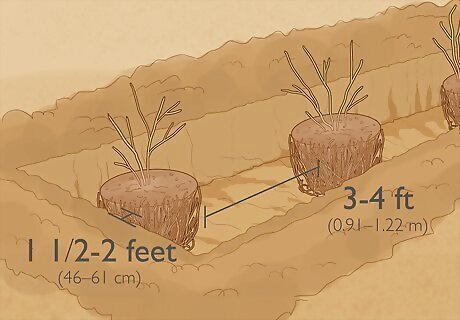
Set your plants in the trench so they’re 3–4 ft (0.91–1.22 m) apart. Position the first shrub so it’s 1 ⁄2–2 feet (46–61 cm) from the end of the trench since it will grow and expand. Keep the shrub in the middle of the trench, and turn it so the fullest side faces your home. Set the next shrub so its trunk is 3–4 feet (0.91–1.22 m) from the first shrub’s trunk. Continue placing the shrubs along the entire length of the hedge fence. Don’t plant the shrubs any closer together, or else they’ll compete for nutrients and won’t grow fully.
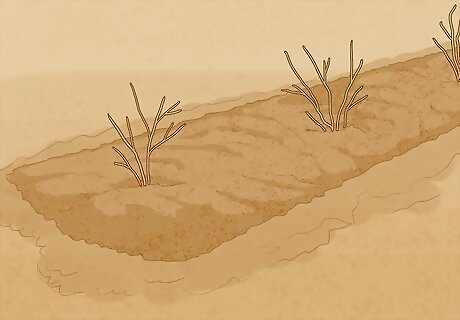
Backfill the soil to form mounds around the shrubs’ trunks. Use your shovel or a wheelbarrow to pour the mixture of soil, compost, and manure back in the trench. Make sure you completely cover the roots for each shrub so they’re not exposed. Compact the soil around the shrubs’ trunks to form small mounds so water doesn’t gather and cause rot.
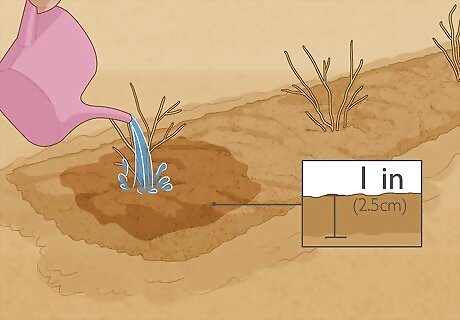
Water the plants until the soil is wet 1 in (2.5 cm) deep. Use a watering can or a garden hose with a sprayer attachment when you water the shrubs. Pour the water as close to the roots as you can so it can absorb into the soil and provide nutrients. Stick your finger into the soil up to the first knuckle to feel if the soil is damp. If it isn’t, continue watering until it does. Avoid using a jet attachment on your hose since you could harm the plants or disturb the soil. You can also use a sprinkler to water your plants.
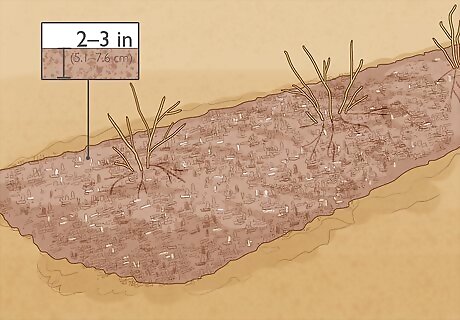
Cover the soil with a 2–3 in (5.1–7.6 cm) layer of mulch. Shovel or pour the mulch on top of the soil between the shrubs. Use a rake to spread the mulch in an even layer on the soil so it’s about 2–3 in (5.1–7.6 cm) deep. Keep the mulch 2 in (5.1 cm) away from the trunks of the shrubs since they could cause rot. You can buy mulch from your local gardening store. Mulch helps retain moisture in the soil and prevents weeds from growing underneath your hedge.
Caring for Your Hedges
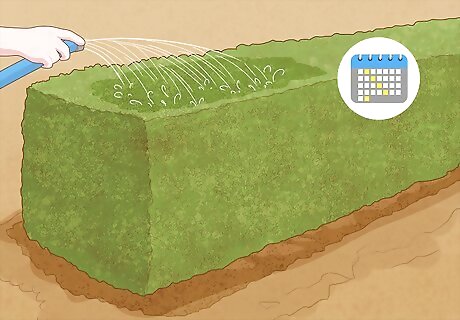
Water the hedge once per week until the soil is completely saturated. Use your watering can or hose to provide water for the shrubs. Try to water the soil evenly around the roots so they can absorb the nutrients and keep the shrubs healthy. Check the soil by sticking your finger into the ground down to the first knuckle. If the soil feels damp, then you can stop watering. If not, continue watering and check again in 5 minutes. If it rains heavily during the week, then you don’t need to water your hedges. Run a drip irrigation system underneath your hedges to provide water for them regularly without having to do it yourself.
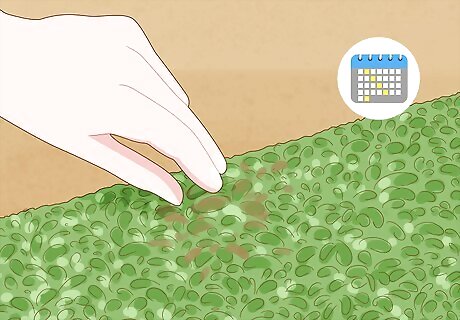
Check for signs of pests or diseases weekly to keep your hedges healthy. Inspect the leaves of the hedges to see if they have holes, bites, or scaly damage on them. Lift the leaves and check the undersides to see if there are any bugs on them. If you find pests, spray a commercial pesticide on the shrubs to get rid of them. If you notice dead branches, shriveled foliage, or yellowing leaves, cut off the affected area so the disease doesn’t spread. Common garden pests include aphids, scale insects, and spider mites. Diseases include powdery mildew, bacterial canker, and blight.Tip: If you aren’t sure what’s wrong with your shrubs, take a clipping of the affected area and take it to your local garden center to diagnose the problem.
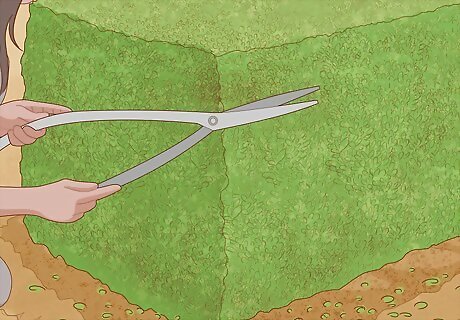
Trim the hedges in the late winter so they get narrower at the top. Opt to prune your hedges after any buds or flowers turn brown so you don’t remove healthy growths. Hold an electric trimmer so the blade is parallel to the side you’re trimming. Guide the hedge trimmer straight across the tops and sides of the shrubs to cut back about ⅓ of the growth. Make sure the top of the hedge tapers narrower than the base, or else the lower branches won’t be able to get sunlight. Hedges usually need to stay at least 3 feet (0.91 m) thick so they can stay healthy and grow.
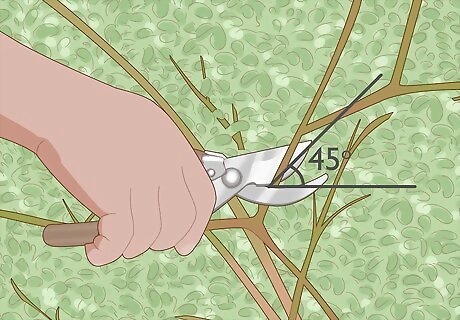
Clip branches inside the hedge every 2–3 ft (0.61–0.91 m) whenever you prune. Reach into the middle of your hedge and grab 1–2 branches. Cut the branches at a 45-degree angle with a pair of hand pruners so water doesn’t pool on top of them. Move at least 2 feet (61 cm) down the hedge and cut 1–2 more interior branches. Continue cutting along the length of the entire hedge fence. Removing interior branches allows more airflow and light to reach the inside of the hedge. Wear long sleeves and gardening gloves if your hedge has thorny branches so you don’t hurt yourself.
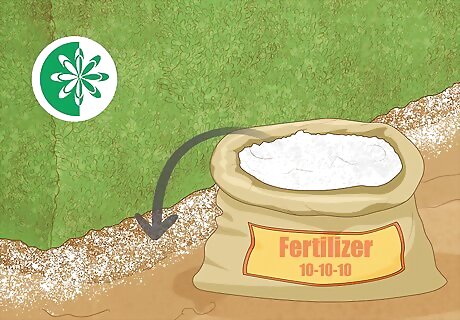
Spread 10-10-10 fertilizer around the hedges every spring. Go to your local gardening store and look for a granular fertilizer to use on your hedges. Scoop out the recommended amount of fertilizer on the package and pour it around the base of the hedge. Water the hedge immediately so the fertilizer can soak into the soil and provide nutrients to your plants. Avoid letting the fertilizer touch the trunks of the shrubs since you could damage them.



















Comments
0 comment